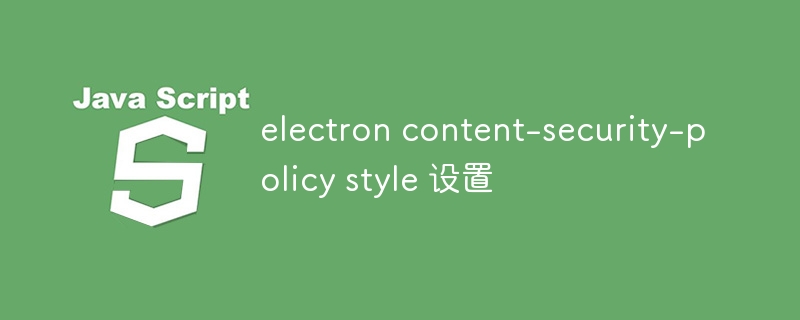电子内容-安全-策略风格设置
- DDD原创
- 2024-08-15 13:46:381070浏览
本文重点介绍 Electron 中样式的内容安全策略(CSP)配置,Electron 是一个应用程序平台,允许开发人员使用 Web 技术构建跨平台桌面应用程序。本文讨论了 'el

如何在 Electron 中为样式配置内容安全策略(CSP)?
要为 Electron 中的样式配置 CSP,可以使用 Electron .session.defaultSession.webRequest.onHeadersReceived 事件。收到请求的标头时会发出此事件,允许您在将标头发送到服务器之前修改标头。electron.session.defaultSession.webRequest.onHeadersReceived event. This event is emitted when a request's headers are received, allowing you to modify the headers before they are sent to the server.
To add a CSP header to a request, you can use the setHeader method on the responseHeaders object. For example, the following code adds a CSP header to all requests:
<code class="typescript">electron.session.defaultSession.webRequest.onHeadersReceived((details, callback) => {
details.responseHeaders['Content-Security-Policy'] = 'default-src \'self\'; style-src \'self\' https://unpkg.com; img-src \'self\' https://unpkg.com https://example.com;'
callback({responseHeaders: details.responseHeaders});
});</code>
What are the best practices for setting up a CSP for styles in an Electron application?
When setting up a CSP for styles in an Electron application, there are a few best practices to follow:
- Use a default-src directive to allow all requests from the same origin. This will ensure that all of your application's styles are loaded.
- Use a style-src directive to specify which origins are allowed to load styles. This will help to prevent cross-site scripting attacks.
- Use a nonce to prevent inline styles from being executed. A nonce is a random value that is generated on the server and included in the CSP header. This helps to ensure that only styles that are loaded from trusted sources can be executed.
Which browser sources are supported by Electron's CSP for styles?
Electron's CSP for styles supports the following browser sources:
-
'self': This source represents the application's own origin. -
'unsafe-inline': This source allows inline styles to be executed. -
'unsafe-eval': This source allows inline scripts to be executed. 'none'要将 CSP 标头添加到请求,您可以使用
setHeader 方法responseHeaders 对象。例如,以下代码向所有请求添加 CSP 标头:- 使用 default-src 指令允许来自同一来源的所有请求。这将确保加载应用程序的所有样式。🎜使用 style-src 指令指定允许哪些来源加载样式。这将有助于防止跨站脚本攻击。🎜
-
使用随机数来防止内联样式nonce 是在服务器上生成并包含在 CSP 标头中的随机值。这有助于确保只能执行从受信任来源加载的样式。🎜🎜🎜Electron 的样式 CSP 支持哪些浏览器源?🎜🎜Electron 的样式 CSP 支持以下浏览器源:🎜
-
'self':此源代表应用程序自己的来源。🎜 -
'unsafe-inline':此源允许执行内联样式。🎜 - 'unsafe-eval':该源允许执行内联脚本。🎜
-
'none':该源不允许加载任何资源。🎜🎜
-
以上是电子内容-安全-策略风格设置的详细内容。更多信息请关注PHP中文网其他相关文章!

